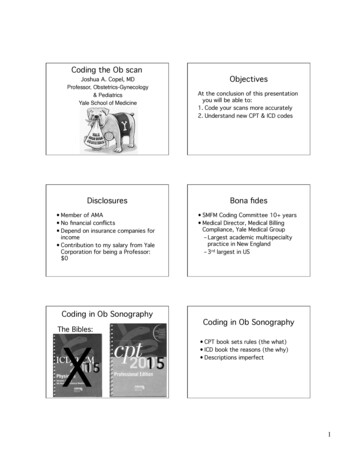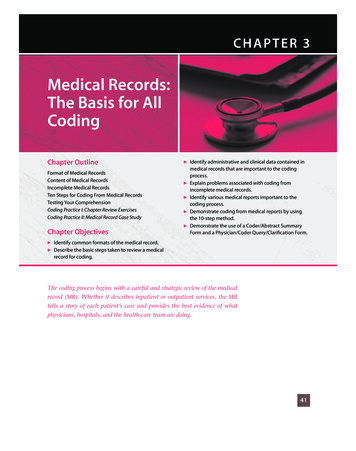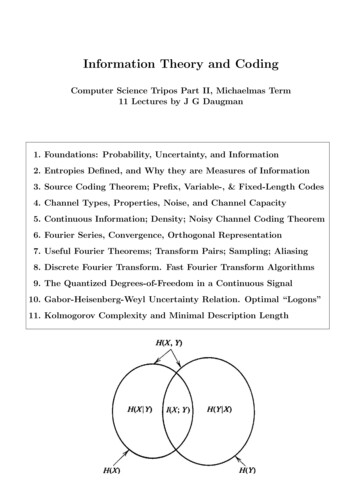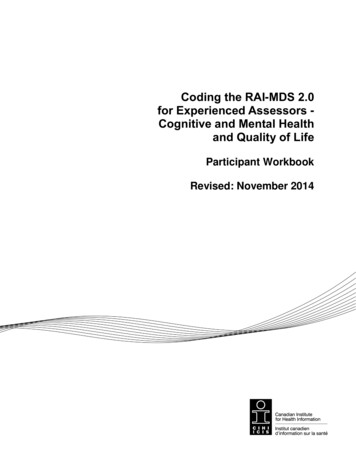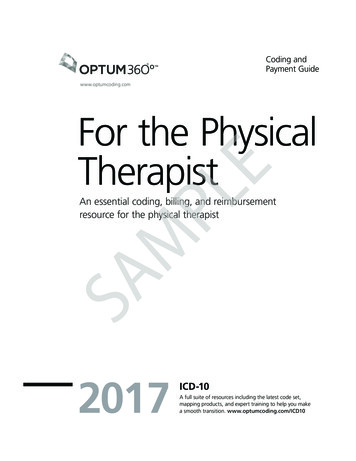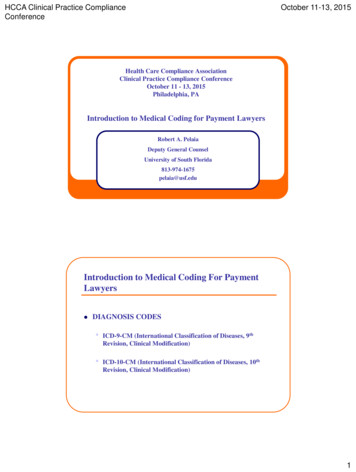
Transcription
HCCA Clinical Practice ComplianceConferenceOctober 11-13, 2015Health Care Compliance AssociationClinical Practice Compliance ConferenceOctober 11 - 13, 2015Philadelphia, PAIntroduction to Medical Coding for Payment LawyersRobert A. PelaiaDeputy General CounselUniversity of South Florida813-974-1675pelaia@usf.eduIntroduction to Medical Coding For PaymentLawyers DIAGNOSIS CODES ICD-9-CM (International Classification of Diseases, 9thRevision, Clinical Modification)ICD-10-CM (International Classification of Diseases, 10thRevision, Clinical Modification)1
HCCA Clinical Practice ComplianceConferenceOctober 11-13, 2015Introduction to Medical Coding For PaymentLawyers PROCEDURE CODES CPT (Current Procedural Terminology, Fourth Edition)ICD-9-CM – Goodbye! InternationalClassification ofDiseases, 9thRevision,ClinicalModification2
HCCA Clinical Practice ComplianceConferenceOctober 11-13, 2015ICD-10-CM – Hello! InternationalClassification ofDiseases, 10thRevision,ClinicalModificationICD-10 - The Book Alphabetic Index to Diseases Presented first in the book and lists the diseases andinjuries in alphabetical order.3
HCCA Clinical Practice ComplianceConferenceOctober 11-13, 2015ICD-10 - The Book Tabular /Numeric List of Diseases Presented second in the book and lists the ICD-10codes in numeric order. Tabular List is a chronological list of codes dividedinto chapters based on body system or condition. 21 ChaptersICD-10 Implementation Dates01/16/09 - Original “final” rule was published. Originalcompliance date for implementation of ICD-10 wasOctober 1, 2013.09/05/12 - New “final” rule was published. Compliancedate for implementation of ICD-10 was moved toOctober 1, 2014.04/01/14 – Law signed by President Obama blockedICD-9 Implementation before October 1, 2015.07/31/14 – CMS officially sets October 1, 2015 as newICD-10 compliance deadline.4
HCCA Clinical Practice ComplianceConferenceOctober 11-13, 2015ICD-10 StructureEtiology,Anatomic M 69,099 diagnosis codes Consists of three to seven characters 1st character is alpha All letters are used except U Second character is numeric 3rd, 4th, 5th, 6th, & 7th characters can be alpha or numeric Decimal is placed after the first three charactersICD-10 Structure Codes in the ICD-10 code set can have three,four, five, six, or seven characters.Many three-character codes are used asheadings for categories of codesThese three-character codes can furtherexpand to four, five, or six characters to addmore specific details regarding the diagnosis.5
HCCA Clinical Practice ComplianceConferenceOctober 11-13, 2015ICD-10 StructureS 8 60 1 1DCategoryEtiology, Anatomic Site, ManifestationExtension This ICD-10 code is for the strain ofright Achilles tendon, subsequentencounter.ICD-10 StructureS 8 60 1 1DCategoryEtiology, Anatomic Site, ManifestationExtensionS Injuries, poisoningand certain otherconsequences of externalcauses related to singlebody regions.S86 Injury of muscle,fascia and tendon oflower legS86.0 Injury of AchillesTendonS86.01 Strain ofAchilles TendonS86.011 Strain of rightAchilles TendonA InitialencounterD SubsequentEncounterS Sequela6
HCCA Clinical Practice ComplianceConferenceOctober 11-13, 2015ICD-10 Chapters Chapter 1 / A00 - B99 Certain Infectious / Parasitic Diseases Chapter 2 / C00 - D49 Neoplasms Chapter 3 / D50 - D89 Diseases of Blood / Diseases of Immune System Chapter 4 / E00 - E89 Endocrine, Nutritional and Metabolic Diseases Chapter 5 / F01 - F99 Mental, Behavioral and Neurodevelopmental Disorders Chapter 6 / G00 - G99 Disease of the Nervous SystemICD-10 Chapters Chapter 7 / H00 - H59 Disease of the Eye and Adnexa Chapter 8 / H60-H95 Diseases of the Ear and Mastoid Process Chapter 9 / I00 - I99 Diseases of the Circulatory System Chapter 10 / J00 - J99 Disease of the Respiratory System Chapter 11 / K00 - K95 Disease of the Digestive System7
HCCA Clinical Practice ComplianceConferenceOctober 11-13, 2015ICD-10 Chapters Chapter 12 / L00 - L99 Diseases of Skin and Subcutaneous Tissue Chapter 13 / M00 - M99 Diseases of Musculoskeletal System and Connective Tissue Chapter 14 / N00 - N99 Diseases of Genitourinary System Chapter 15 / O00 - O9A Pregnancy, Childbirth, and the Puerperium Chapter 16 / P00 - P96 Conditions Originating Perinatal PeriodICD-10 Chapters Chapter 17 / Q00 - Q99 Congenital Malformations and Chromosomal Abnormalities Chapter 19 / R00 - R99 Symptoms, Signs, and Abnormal Clinical and Lab Findings Chapter 19 / S00 - T88 Injury, Poisoning, Certain Other External Causes Chapter 20 / V00 - Y99 External Causes of Morbidity Chapter 21 / Z00 – Z99 Factors Influencing Health Status and Contact with HealthServices8
HCCA Clinical Practice ComplianceConferenceOctober 11-13, 2015Dummy Placeholders Not every ICD-10 code with a seventh character has a sixth character- or even a fifth or fourth character for that matter. The letter “X” serves as a dummy placeholder when a code containsfewer than six characters and a seventh character applies. When selecting ICD-10-CM codes, coders must add a placeholder sothe seventh character is in the correct position. EXAMPLE: T15.12XAForeign body in conjunctival sac, left eye, initial encounter. ICD-10 ExamplesS and 5Z and 2I and 1O and 0 I Codes – Diseases of Circulatory System I63.011 – Cerebral infarction due to thrombosis of rightvertebral artery O Codes – Pregnancy/Childbirth O24.013 - Pre-existing diabetes mellitus, type 1, inpregnancy, third trimester9
HCCA Clinical Practice ComplianceConferenceOctober 11-13, 2015ICD-10 Examples - Laterality “Laterality” (side of the body affected) is a new codingconvention added to relevant ICD-10 codes to increasespecificity. Designated codes for conditions such asfractures, burns, ulcers, and certain neoplasms will requiredocumentation of the side/region of the body where thecondition occurs.ICD-10 Examples - Laterality In ICD-10, laterality code descriptions includeright, left, bilateral, or unspecified designations: The right side character 1 The left side character 2 Bilateral character 3 Unspecified side/region character 0 or 9(depending on whether it is a 5th or 6thcharacter).10
HCCA Clinical Practice ComplianceConferenceOctober 11-13, 2015ICD-10 Examples - Laterality ICD-9 370.03 - Central Corneal UlcerAssigning ICD-10 Codes1. Completely review all medical recorddocumentation.2. Abstract the medical conditions thatshould be coded.3. Identify the main term for eachdiagnosis.4. Locate the main term in theAlphabetic Index.5. Verify the code in the Tabular List byreading the notes & following theguidelines.11
HCCA Clinical Practice ComplianceConferenceOctober 11-13, 2015Assigning ICD-10 Codes Step 1 Completely review all medical record documentation in orderto properly identify the terms that best describe the patient’sdiagnosis.Assigning ICD-10 Codes Step 2 Abstract the medical conditions that should be coded.12
HCCA Clinical Practice ComplianceConferenceOctober 11-13, 2015Assigning ICD-10 Codes Step 3 Identify the main term for each diagnosis reflected in themedical record. Main terms identify the diseases, injury orconditions.Diseases InfluenzaBronchitisConditions FatigueFractureInjuryNouns or Adjectives Disease, disturbance, syndromeAberrant, abnormal, enlargedAssigning ICD-10 Codes Step 4 Look up the main term that best describe the patient’sdiagnosis in the alphabetic index and identify the ICD-10 codethat appears to best matches the diagnosis.13
HCCA Clinical Practice ComplianceConferenceOctober 11-13, 2015Assigning ICD-10 Codes Step 5 Look up the selected code in the tabular/numerical list tomake the code selection. Careful attention should be paid to“includes” and “excludes” notes and other instructions.Code to the highest level of specificity.Assigning ICD-10 Codes It is essential to use both the Index and the TabularList when selecting a code. Selection of the full code,including laterality and any applicable 7th character,can only be done in the Tabular list. A dash (-) at the end of an Index entry means thatadditional characters are required. Even if a dash isn’t present, you must refer to theTabular list to verify that no 7th character is required.14
HCCA Clinical Practice ComplianceConferenceOctober 11-13, 2015Mini ICD-10 Quiz Roger suffers from paralysis of his upperright arm. He is left-handed.Mini ICD-10 Quiz Melissa presents with a boil in theexternal ear of the left side.15
HCCA Clinical Practice ComplianceConferenceOctober 11-13, 2015Mini ICD-10 Quiz A 79 year old with osteoporosis presentswith a new pathological fracture of theright femur.Mini ICD-10 Quiz Rhonda was treated at her dermatologistfor basal cell carcinoma of the skin of thechin.16
HCCA Clinical Practice ComplianceConferenceOctober 11-13, 2015CPT Current ProceduralTerminology,Fourth EditionCPT BackgroundCPT was developed and published in 1966 by the American MedicalAssociation. The current version, CPT 2008, is referred to as “CPT-4”because it is the fourth edition of CPT. Annual updates of CPT are notconsidered new editions. ApplicationCPT is used for reporting physician (professional) services and technicalservices provided with the professional services.17
HCCA Clinical Practice ComplianceConferenceOctober 11-13, 2015CPT UpdatingCPT Codes are updated through a deliberative process of adding,deleting, and revising codes.CPT codes are updated and revised by the AMA’s CPT Editorial Panelon an annual basis.CPT OrganizationCPT is divided into six sections, followed by six appendices andan alphabetic index. The CPT codes are listed in numeric orderwithin sections and subsections.Evaluation and Management (99201 – 99499)Anesthesia (00100 – 01999)Surgery (10021 – 69990)Radiology (70010 – 79999)Pathology and Laboratory (80047 – 89356)Medicine (90281 – 99607)18
HCCA Clinical Practice ComplianceConferenceOctober 11-13, 2015CPT Organization Section guidelines appear at the beginning of each of the sixCPT sections. Subsection guidelines appear at the beginning of many of thesubsections. The guidelines provide definitions and additional informationto assist in the proper selection of CPT codes within thecorresponding section or subsection.CPT Evaluation and Management Codes Key Components HistoryExamMedical Decision MakingNew Patient vs. Established Patient19
HCCA Clinical Practice ComplianceConferenceOctober 11-13, 2015SELECTING LEVEL OF E&M CODESHistory - Levels and TypesSELECTING LEVEL OF E&M CODESSelect an E&MCode in 7 EasySteps!20
HCCA Clinical Practice ComplianceConferenceOctober 11-13, 2015SELECTING LEVEL OF E&M CODESHISTORY (new patient)Step 1 - Determine the “name” level of theHistory component, which will be either Problem-focused,Expanded problem-focused,Detailed, orComprehensive.SELECTING LEVEL OF E&M CODESHISTORY (new patient)Step 2 - Convert this “name” level of history intoa “number” level.Problem-focused Level 1Expanded problem-focused Level 2Detailed Level 3Comprehensive Levels 4 & 521
HCCA Clinical Practice ComplianceConferenceOctober 11-13, 2015SELECTING LEVEL OF E&M CODESEXAM (new patient)Step 3 - Determine the “name” level of the Examcomponent, which will be either Problem-focused,Expanded problem-focused,Detailed, orComprehensive.SELECTING LEVEL OF E&M CODESEXAM (new patient)Step 4 - Convert this “name” level of exam into a“number” level.Problem-focused Level 1Expanded problem-focused Level 2Detailed Level 3Comprehensive Levels 4 & 522
HCCA Clinical Practice ComplianceConferenceOctober 11-13, 2015SELECTING LEVEL OF E&M CODESMEDICAL DECISION MAKING (new patient)Step 5 - Determine the “name” level of theMedical Decision Making component, which willbe either Straightforward,Low complexity,Moderate complexity, orHigh Complexity.SELECTING LEVEL OF E&M CODESMEDICAL DECISION MAKING (new patient)Step 6 - Convert this “name” level of MedicalDecision Making into a “number” level.Straightforward Levels 1 & 2Low complexity Level 3Moderate complexity Level 4High Complexity Level 523
HCCA Clinical Practice ComplianceConferenceOctober 11-13, 2015SELECTING LEVEL OF E&M CODESPutting It All TogetherNOTE: The same “name” level of an element mayresult in a different “number” level depending on thetype of service beingFor instance, a Detailed history translates to a Level 3when looking at the NEW Patient Office Visit range ofcodes (99203).HOWEVER, a Detailed history translates to a Level 4when looking at the ESTABLISHED Patient OfficeVisit range of codes (99214).SELECTING LEVEL OF E&M CODESPutting It All TogetherIn cases where a “name” level is associated with TWOnumber levels, credit the higher number level.For example: in the NEW Patient Office Visit subcategory, aComprehensive level of history is associated with both theLevel 4 and Level 5 codes within that category, so theComprehensive history would be converted to a (number)Level 5 history in this category.24
HCCA Clinical Practice ComplianceConferenceOctober 11-13, 2015SELECTING LEVEL OF E&M CODESPutting It All TogetherIn cases where a “name” level is associated with TWOnumber levels, credit the higher number level.Another example: in the NEW Patient Office Visitsubcategory, a Straightforward level of MDM is associatedwith both the Level 1 and Level 2 codes within that category,so the Straightforward MDM should always be converted toa (number) Level 2 MDM in this category.SELECTING LEVEL OF E&M CODESPutting It All TogetherStep 7 - With a “number” level in hand for each of thethree key components, determine whether you must nowapply the “3/3 rule” or “2/3 rule” to arrive at the finalcode level for the category in question.3/3: When using the 3/3 rule, the LOWEST of the threeindividual component levels IS the final visit level.2/3: When using the 2/3 rule, the NEXT-TO-LOWESTcomponent level IS the final visit level.25
HCCA Clinical Practice ComplianceConferenceOctober 11-13, 2015SELECTING LEVEL OF E&M CODESPutting It All Together Mini E&M Quiz New Patient Visit (3/3 rule) Level 3 History (detailed) Level 3 Exam (detailed) Level 2 MDM (straightforward)SELECTING LEVEL OF E&M CODESPutting It All Together Mini E&M Quiz New Patient Visit (3/3 rule) Level 5 History (comprehensive) Level 4 Exam (comprehensive) Level 3 MDM (low complexity)26
HCCA Clinical Practice ComplianceConferenceOctober 11-13, 2015SELECTING LEVEL OF E&M CODESPutting It All Together Mini E&M Quiz Established Patient Visit (2/3 rule) Level 4 History (detailed) Level 3 Exam (expanded problem focused) Level 2 MDM (straightforward)SELECTING LEVEL OF E&M CODESPutting It All Together Mini E&M Quiz Established Patient Visit (2/3 rule) Level 2 History (problem-focused) Level 2 Exam (problem-focused) Level 3 MDM (low complexity)27
HCCA Clinical Practice ComplianceConferenceOctober 11-13, 2015Assigning CPT Codes Step 1Review the medical record documentation in order to properlyidentify the terms that best describe the service.Assigning CPT Codes Step 2Look up the terms that best describe the service in the CPT indexand identify the CPT code that best matches the service.28
HCCA Clinical Practice ComplianceConferenceOctober 11-13, 2015Assigning CPT Codes Step 3Look up the selected code in the main section of CPT to make thecode selection. Careful attention should be paid to use ofmodifiers.Mini CPT Quiz Soft Tissue Shoulder Biopsy Removal of Foreign Body, External Eye; ConjunctivalSuperficial Electrolyte Panel - Pathology 29
HCCA Clinical Practice ComplianceConferenceOctober 11-13, 2015CPT Modifier ExamplesModifier 25 - Significant, Separately Identifiable E&M Service by theSame Physician on the Same Day of the Procedure or Other Service.Modifier 25 is used to describe separate, distinctly identifiable services fromother services or procedures rendered during the same visit. Always attachthe modifier to the evaluation and management code.Modifier 57 - Decision for Surgery.Modifier 57 is used when an evaluation and management (E&M) serviceresulted in the initial decision to perform surgery. Major surgical procedure isdefined by CMS as a procedure having a 90-day global period assigned byCMS. The global period includes the 1-day prior to surgery.Top 10 Takeaways1. ICD-10 Codes are Diagnosis Codes2. ICD-10 was Effective October 1, 20153. ICD-10 Index / Alphabetic4. ICD-10 Tabular / Numeric5. CPT Codes are Procedure Codes30
HCCA Clinical Practice ComplianceConferenceOctober 11-13, 2015Top 10 Takeaways6. E&M Codes Have 3 Key Components7. History / Exam / MDM8. New Patient E/M 3 Key Components9. Established E/M 2 Key Components10. Code to Highest Level of SpecificityQuestions & Answers31
October 11-13, 2015 4 ICD-10 - The Book Tabular /Numeric List of Diseases Presented second in the book and lists the ICD-10 codes in numeric order. Tabular List is a chronological list of codes divided into chapters based on body system or condition. 21 Chapters ICD-10 Impl
